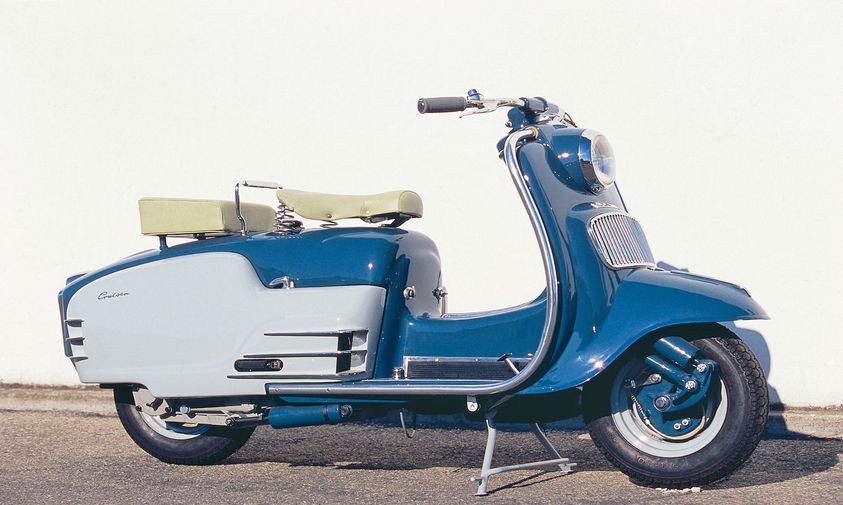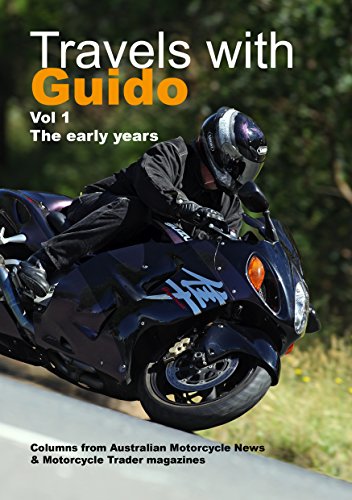Motorcycle Investor mag
Subscribe to our free email news
Ducati Cruiser
(by Ian Falloon, Apr 2022)

Despite
some courageous engineering, Ducati's innovative first
scooter bombed
When the MotoGP
Desmosedici screams past at more than 350km/h, turning
nearly 20,000rpm, it is
difficult to believe that seventy years ago Ducati was
basically only producing
small motorcycles suitable for basic transportation.
Ducati’s initial foray
into motorcycle manufacture was the Cucciolo, or little
pup, a 50cc clip-on
engine for a bicycle. After the Second World War the
Ducati factory was a
bombed out ruin, and out of a necessity for survival the
company began to
produce the Cucciolo, a design created by Aldo Farinelli
of Turin in 1945.
Farinelli worked for
Siata (Societa Italiana per Applicazione Techiche
Auto-Aviatore) but the
Cucciolo was to become a Ducati success story. It grew
from 49 to 65cc, and
eventually powered a line of lightweight motorcycles and
mopeds through until
1956.
So successful was the
Cucciolo, that in 1951, Ducati’s management decided it
was time to produce a
real motorcycle, and mount a challenge to the recently
released two-stroke Vespa
and Lambretta scooters.
In 1950 their designer
Giovanni Fiorio designed a new engine, a 65cc
four-stroke with pushrod operated
valves. Introduced in March 1950, and called the 60
Sport, it was the first
Ducati motorcycle, and this engine would form the basis
of a complete range of
pushrod singles lasting through until the 125 Cadet of
1967. Shortly afterwards
he set to work on a scooter, known as the Cruiser.
By 1951 all production
was concentrated at Borgo Panigale, with the company
headquarters moving from
Largo Augusto, 7, Milan. In October 1951, Dottore
Giuseppe Montano was made
director of Ducati, and the path that eventually saw
Ducati as one of Italy’s
premier motorcycle manufacturers, begun. Montano would
control the company for
nearly two decades, seeing it through some difficult
times and near disasters,
but he was instrumental in maintaining its survival
through the turbulent
1960s.
There were some
notable successes but one of the early disasters for
Ducati was the Cruiser.
Considering the size of the company, the Cruiser was an
amazingly ambitious
project. Unlike the Vespa and Lambretta, the Cruiser was
powered by a
four-stroke engine, and was envisaged as a luxury model
in an effort to appeal
to a new, and more prosperous, clientele.
Fiorio’s engine was a
single cylinder, with a bore and stroke of 62 x 58 mm.
Displacing 175cc, the
air-cooled, the horizontal engine was transversely
mounted under the seat. The
two opposed overhead valves had an included valve angle
of 80 degrees, and were
operated by pushrods.
A single Dell’Orto
carburettor was mounted directly on the cylinder heads,
feeding downdraft into
the cylinder. Initially the engine produced 12
horsepower, but was detuned to 8
horsepower at 6000 rpm through a lower compression ratio
(7.5:1). This was due
to a government imposed 80km/h speed limit for scooters.
A first for a scooter
was the standard electric starter, and at a time when
just about all cars and
motorcycles used a weak 6-volt the electrical system,
the Cruiser had 12-volt
electrics.
The 45-watt dynamo
powered, a huge for the day, 32-amp hour battery, both
positioned above the
engine. As a result, the Cruiser’s lighting was
exceptional, and far superior
to other motorcycles and scooters.
Even more remarkable
than the engine and electrical system was the gearbox.
Running longitudinally
under the seat, this was automatic, with a hydraulic
torque-converter housed in
an alloy casting that incorporated the swingarm pivot.
Fitting a
torque-converter was an unusual feature for 1951, and
the system was
essentially similar to that of the Moto Guzzi V1000
Convert more than two
decades later.
Unfortunately, while
commendable in endeavouring to make the Cruiser a
user-friendly machine, the
automatic gearbox was extremely complicated and the
technology for such a
vehicle was in its infancy. The gearbox also caused
Ducati considerable
concern, as there were numerous warranty claims.
Running lengthways
under the rear bodywork, the gearbox drove the rear
wheel via a short
connecting shaft to a crown wheel and pinion. It was a
clever design, and like
the automatic gearbox was intended to provide ease of
use with minimal
maintenance.
The
swingarm/transmission casting was supported by a single
oil damped shock
absorber on the opposite side of the wheel, while the
front suspension also
included a single shock absorber. Small scooter-size
10-inch wheels were shod
with 3.50x10 Pirelli what wall tyres.
In the creation of the
Cruiser Ducati spared no expense, engaging an outside
design house to style the
bodywork. Although they initially only admitted that the
bodywork was designed
“by a well-known car design company,” it eventually
transpired that it was done
by Ghia. Ghia was then, and now, better known for luxury
cars, and the
Cruiser’s styling was unremarkable.
Later Alessandro de
Tomaso acquired Ghia, and Ford eventually bought the
company. It was Ducati’s
first example of involving an automotive styling concern
and was a failure.
Ducati later repeated this mistake with Giorgetto
Giugiaro’s 860 GT of 1975.
Other features
included a separate sprung seat for the rider, with a
pillion seat behind, a
single built-in headlight above a front grille, and
hinged side panels to allow
access to the engine. A spare tyre was located under the
left-hand panel, but
the Cruiser was substantially heavier than its
two-stroke competition and
considerable more difficult to manhandle and put on its
stand.
Released at the Milan
Show in January 1952, the Cruiser was hailed as a
highlight because of its
technical innovation. On paper it looked to have the
goods. Automatic
transmission, electric start, crown wheel and pinion
final drive, and a 12-volt
electrical system, but it wasn’t enough. Despite being
the world’s first
four-stroke scooter, and amazingly advanced for its day,
the Cruiser was doomed
from the start.
As a motorcycle
manufacturer Ducati had no experience in building
scooters, and no reputation.
Against the established and successful Vespa and
Lambretta, the Cruiser was
seen as heavy and complicated, contravening the reasons
that made scooters
popular. The fuel consumption was comparable to that of
the two-strokes, but
when the engine was detuned acceleration suffered.
On top of the
increased maintenance the four-stroke demanded (oil
changes and valve
adjustment) the Cruiser was also burdened with a high
price. Although entering
production during 1952, the Cruiser was a commercial
failure. Production ended
towards the end of 1953 with only 2000 produced.
Because they were
unreliable and unpopular, very few have survived, but
Primo Forasassi has
recently restored this example for the Museo Ducati, in
the original colours of
blue and grey.
The Cruiser debacle
showed that a motorcycle manufacturer like Ducati should
concentrate on what
they knew best, build motorcycles. Yet even Ducati
didn’t learn from this
mistake, and a decade after the Cruiser’s demise they
released the Brio. The
Brio was an equally unconvincing attempt at producing a
scooter. This time
powered by 50, and later 100cc, two-stroke engines, it
lasted from 1964 to
1969.
-------------------------------------------------
Produced by AllMoto abn 61 400 694 722
Privacy: we do not collect cookies or any other data.

Archives
Contact





